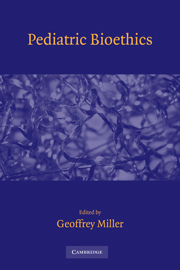Book contents
- Frontmatter
- Contents
- Contributors
- Preface
- A THE FOUNDATION: THEORY AND PRINCIPLES
- 1 Virtues and Goals in Pediatrics
- 2 Contributions of Ethical Theory to Pediatric Ethics: Pediatricians and Parents as Co-fiduciaries of Pediatric Patients
- 3 Using the Best-Interests Standard in Treatment Decisions for Young Children
- 4 The Moral and Legal Status of Children and Parents
- 5 The Ethics of Pediatric Research
- 6 Truth Telling in Pediatrics: What They Don't Know Might Hurt Them
- 7 Pediatric Ethics Committees
- B GENETICS AND THE NEWBORN
- C THERAPIES
- D END OF LIFE
- Index
5 - The Ethics of Pediatric Research
Published online by Cambridge University Press: 07 May 2010
- Frontmatter
- Contents
- Contributors
- Preface
- A THE FOUNDATION: THEORY AND PRINCIPLES
- 1 Virtues and Goals in Pediatrics
- 2 Contributions of Ethical Theory to Pediatric Ethics: Pediatricians and Parents as Co-fiduciaries of Pediatric Patients
- 3 Using the Best-Interests Standard in Treatment Decisions for Young Children
- 4 The Moral and Legal Status of Children and Parents
- 5 The Ethics of Pediatric Research
- 6 Truth Telling in Pediatrics: What They Don't Know Might Hurt Them
- 7 Pediatric Ethics Committees
- B GENETICS AND THE NEWBORN
- C THERAPIES
- D END OF LIFE
- Index
Summary
In general terms, the ethics of adult participation in research is fairly straightforward: adults must consent to being the subjects of research and, in doing so, assert their autonomy in determining the discretionary use of their bodies. But unlike adults, children cannot give such consent. Many have not yet matured sufficiently to understand the risks and benefits of participating in a study, and they are not yet fully able to weigh the pros and cons of participation for themselves or to contribute to new knowledge that may help future generations of children. Yet there is a consensus that children's participation in research may be ethically justifiable under certain conditions.
There is ample reason for caution. The history of research with children reveals that the interests of child participants were not always protected and that in some cases researchers exploited children. In the past 40 years, however, the United States has developed guidelines and regulations to protect children from serious and unnecessary risks and to safeguard their best interests. While these standards are intended to be as straightforward as are regulations for adults, there is still room for misinterpretation and controversy.
HISTORICAL PERSPECTIVES
Most documentation of pediatric research was scant until the 18th century. In fact, most pediatric writing until the late 1600s focused on simple observations, folklore, and trial and error. The physiology of children and adolescents was not explored at this point, and infant and maternal mortality rates were consistently high. During the 17th century, there was a rebirth of medicine, and physicians took an interest in children and their ailments. This great interest in disease led to the introduction of a smallpox vaccine in the 18th century.
Keywords
- Type
- Chapter
- Information
- Pediatric Bioethics , pp. 54 - 72Publisher: Cambridge University PressPrint publication year: 2009

